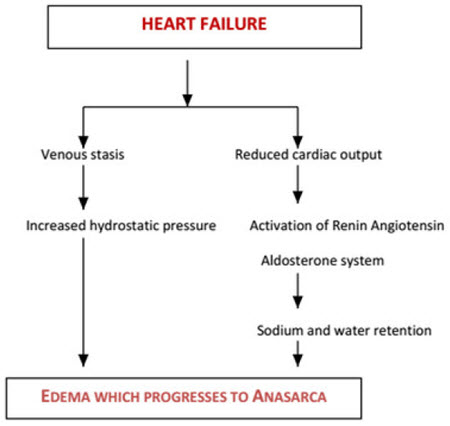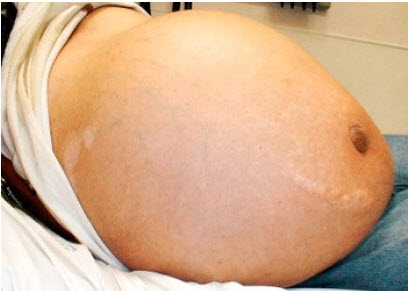{ DOWNLOAD AS PDF }
 ABOUT AUTHORS
ABOUT AUTHORS
L Reddenna1*, Dr. P. Venkatesh1, K Siva Kumar2, A Sai keshava Reddy2
1* Department of Pharmacy Practice,
Jagan’s College of Pharmacy,
Nellore, Andhra Pradesh, India
2 Department of Pharmacy Practice,
Nirmala College of Pharmacy, Kadapa, Andhra Pradesh, India
*reddennapharmd@gmail.com
ABSTRACT
Anasarca is the medical term referred to an individual who experiences generalized oedema. Anasarca is diverse from slight swelling or oedema that occurs mainly in the feet. Anasarca is very familiar in patients with heart failure and kidney failure. Anasarca happens because there is an underlying problem. A selection of diagnostic methods can be used in a challenge to make a diagnosis of anasarca. Formerly anasarca and the underlying problem is diagnosed, suitable measures will be made to treat the problem. In this section, we can communicate the information regarding anasarca.
REFERENCE ID: PHARMATUTOR-ART-2510
|
PharmaTutor (Print-ISSN: 2394 - 6679; e-ISSN: 2347 - 7881) Volume 5, Issue 8 Received On: 13/04/2017; Accepted On: 21/04/2017; Published On: 01/08/2017 How to cite this article: Reddenna L, Venkatesh P, Kumar KS, Reddy ASK;Anasarca: A generalized swelling; PharmaTutor; 2017; 5(8);41-45 |
INTRODUCTION
Anasarca is the medical term referred to an individual who experiences generalized oedema. This happens because there is an excess fluid build-up in the tissues. Anasarca is diverse from slight swelling or oedema that occurs mainly in the feet. In anasarca, the individual looks like bloating and when the person is pinched, the skin will not go back to its usual condition right away. Here are some of the localized forms:
• Abdominal and facial swelling
• Angioedema
• Swollen gums, glands and joints
• Swollen legs, ankles, and feet
Anasarca Causes
1. Increased hydrostatic pressure
a. Impaired venous outflow
• Congestive heart failure
• Constrictive pericarditis
• Liver cirrhosis
• Venous obstruction due to large tumors
b. Arteriolar dilatation
• Neurohumoral dysregulation
2. Reduced osmotic pressure
3. Reduced protein intake
• Protein malnutrition – Kwashiorkor
• Starvation
4. Reduced protein synthesis
• Liver cirrhosis
5. Increased excretion of protein
• Protein losing glomerulopathies – Nephrotic syndrome
• Protein losing enteropathy
6. Sodium retention
• Increased salt intake with renal insufficiency
• Increased reabsorption of sodium
• Increased renninangiotensin- aldosterone mechanism
• Mineralocorticoid excess
7. Some drugs- like anabolic steroids, steroids like prednisolone
Anasarca is not a disease itself but it is a symptom of an underlying condition like malnutrition or occasionally protein deficiency; administration of a chemotherapeutic drug like doxetaxel and administration of exogenous intravenous fluid. Anasarca is very familiar in patients with heart failure and kidney failure.
Cardiac problems and renal failure is one of the ordinary diseases that individuals experience globally. Oedema and even anasarca occurs in patients with kidney failure because there is a loss or protein in the urine and the kidney cannot function well thus water and other toxins will be reserved in the body. On the other hand, for patients with heart failure, there is a deprived cardiac function so there is slighter blood volume that is pumped by the heart to be delivered in the other parts of the body. Consequently, the kidney will then sense that there is a decreased blood volume in the body. To balance for that problem, the kidney will retain salt and water thus, oedema happens. [1]
Salt ingestion also affects the body thus anasarca occurs. In an ordinary person, the salt is well-regulated and it is excreted in the body through urine. So when the patient has heart failure or kidney failure, the quantity of salt should be partial to avoid anasarca. There is also a situation called idiopathic oedema. The cause is mysterious but it is correlated with pre-menopausal women and those who took diuretics for a long time. Although diuretics can significantly reduce oedema through urination, it can also cause difficulty through rebound phenomenon. It is supposed that there are leaks in the capillaries in idiopathic oedema. Then the fluid passes to the interstitial space and the kidney will then retain salt and water because it senses that there is a decreased blood volume.
Congestive heart failure, also known as congestive cardiac failure, is usually brought on by low cardiac output. Conversely, it can also happen when the body requires more nutrients and oxygen, and the heart does not supply it as rapidly as the body needs. The final circumstance may take place in certain conditions, for example, hyperthyroidism, Paget's disease, and severe anaemia.
Liver failure, due to cirrhosis - In this case, the cirrhosis of the liver at last leads to its failure. Cirrhosis can also lead to a multiplicity of other complications aside from liver failure. Frequent medical causes can lead to cirrhosis, but some of those possibilities include: alcoholic liver disease (ALD), chronic hepatitis B or C, autoimmune hepatitis, and Non-alcoholic steatohepatitis (NASH).
Kidney disease, known as nephropathy, can lead to anasarca. It can be caused by chronic issues such as high blood pressure, diabetes mellitus, and systemic lupus erythematosus (SLE), as well as exposure to lead or lead salts, and xanthinuria (xanthine oxidase deficiency), amongst other items. The condition is sometimes known by its previous name, nephrosis.
Severe malnutrition is another possible anasarca cause. Malnutrition of exacting vitamins, minerals, nutrients, and various necessary items can lead to diverse medical problems, based upon the type of deficiency. For example, a vitamin B12 deficiency can cause pernicious anaemia. Malnutrition of any specific thing may not essentially lead to anasarca. A severe protein deficiency is one prospect that can result in such a condition.
Systemic capillary leak syndrome, also known as Clarkson syndrome, can cause generalized swelling. The condition is unusual. In it, the pores in the blood capillaries enlarge in size and in count. This causes fluid to leak from the blood and into the interstitial fluid. Swelling, decreased blood pressure and failure of multiple organs can follow.
Pathophysiology of Anasarca
As Anasarca is the steady progression of the swelling, the pathophysiology of anasarca is the similar as that of oedema, only for a longer duration and with further severity. To comprehend the mechanism, one should know a few applicable facts. About 60% of our lean body weight is made up of water of which two third lies within the cells (40%) and one third lies outside the cells (20%). The extracellular fluid can be divided into interstitial fluid, the fluid that lies in between the cells (IF 15%) and plasma fluid which lies within the blood vessels (5%). Accumulation of surplus fluid in the interstitial space between the tissues causes oedema.
This can occur due to
• Abnormal leak of plasma fluid to interstitial space
• Increased hydrostatic pressure
• Reduced plasma osmotic pressure
• Sodium Retention
Malfunction of lymphatic vessels to return excess fluid from interstitium to plasma
• Lymphatic obstruction
• Major surgery
• Some cancers
NOW YOU CAN ALSO PUBLISH YOUR ARTICLE ONLINE.
SUBMIT YOUR ARTICLE/PROJECT AT editor-in-chief@pharmatutor.org
Subscribe to Pharmatutor Alerts by Email
FIND OUT MORE ARTICLES AT OUR DATABASE
Anasarca Symptoms
Anasarca happens because there is an underlying problem. For patients with kidney failure, they will also experience:
• Nausea
• Anemia
• Vomiting
• Loss of appetite
• Cramps
• No urine output
• Swelling of the feet and ankle
• Body weakness
• Shortness of breath
For patients with congestive heart failure aside from anasarca, symptoms comprise:
• Unable to sleep at night unless sitting upright
• Shortness of breath
• Body weakness
• Decreased appetite
• Abdominal pain
For patients with idiopathic oedema, the patient there will be overstated leg oedema when the patient is standing up. Aside from that, there is an obvious peri-orbital oedema or swelling around the eyes particularly in the morning.
Anasarca in heart failure
Congestive heart failure or right heart failure is the most ordinary and most severe cause of Anasarca. As accurately said, Heart is a pump that pushes the blood throughout the body. The distributed blood again reaches the heart and the cycle continues. When the heart fails to pump, the circulated blood (venous blood) is slowed down from pumped again leading to venous stasis. It leads to augmented hydrostatic pressure and oedema. The oedema begins in the most reliant part primarily – feet and ankle and then becomes a full blown Anasarca when the heart’s function has deteriorated to great extent. [2]

Anasarca in nephrotic syndrome
Nephrotic syndrome is a kidney disease of children in which the filter like glomerular membrane become leaky to the plasma proteins like albumin. So a huge amount of albumin is lost in urine which lowers the colloid osmotic pressure. Primarily the oedema begins in loose tissues around the eyes giving a puffy eye manifestation which then steadily progress to Anasarca when the plasma protein level falls below 2.5 gm/100ml which is less than one third of normal level. Other kidney diseases affect the excretion of sodium and water which leads to extreme intravascular fluid volume leading to oedema.
Anasarca in Liver diseases
The most ordinary liver disease causing Anasarca is Liver cirrhosis. Liver is the factory built-up the plasma proteins. When the serviceable parenchymal cells, the workers of liver get replaced by useless fibrous tissue, it leads to low protein production. This leads to low osmotic pressure and fluid leak to the interstitium. Another mechanism is that, fibrous scar in the liver squeeze the portal vessels which pass through the liver, leading to amplified hydrostatic pressure in the veins of abdominal organs. This leads to accumulation of fluid in peritoneal cavities which is known as hydroperitonium or Ascites.

Anasarca in Children
The main cause of Anasarca in children is protein energy malnutrition – Kwashiorkor in which the protein deficiency is more severe than energy malnutrition. It is most usually seen in children of 14yrs of the impecunious Southeast Asian countries and African children are who are weaned early. Infrequently, premature infants develop hypoprotenemic oedema due to immature liver which doesn’t produce the sufficient plasma proteins.

Anasarca diagnosis
A selection of diagnostic methods can be used in a challenge to make a diagnosis of anasarca. These tests and other process are to be administrated by a doctor or medical professional who knows how to perform them and construe the results. Underneath is some essential information on diverse types of tests and methods that are used in some conditions. These may be related to either anasarca or localized swelling, or potentially both.
Albumin blood test - Low levels of albumin can lead to swelling. This test can observe whether there is hypoalbuminemia, or insufficient albumin blood levels. Serum albumin is the most ordinary plasma protein in the human body, and it is used in diverse functions such as maintaining osmotic pressure, and by being used as a plasma carrier.
Echocardiogram and electrocardiogram - Both tests of the heart, the echocardiogram is a sonogram, while the electrocardiogram interprets heart electrical activity over a period of time. The echocardiogram can be known as cardiac ECHO or cardiac ultrasound, while the electrocardiogram often goes by the condensed forms of ECG or EKG.
Kidney and liver function tests - These two test the function of their individual organs. For the kidney, glomerular filtration rate (GFR) or creatinine clearance rates (CCR) are two tests that determine different aspects of renal function. Several of the common liver function tests, including liver enzymes, are alanine transaminase (ALT), alkaline phosphatase (ALP), direct bilirubin, and total bilirubin (TBIL).
Urinalysis, summarized as a simple UA, is a term to explain a collection of tests that are administered on the patient's urine. Some urinalysis can use dipsticks, and in such cases the results are seen as the color on the stick changes. Tests performed using urinalysis can include those such as the following examples: pH (acidity), ketone bodies, proteins, hyperthyroidism, and jaundice, as well as others.
This is not projected to be a complete list of diagnostic tests; however, some other items which can be used in certain cases for an attempted anasarca or other swelling diagnosis include a blood electrolyte level test, and X-rays of the individual.
Differential Diagnosis of Anasarca
• Congestive heart failure
• Heart failure due to thiamine deficiency
• Heart failure due to cardiac cirrhosis
• Nephrotic syndrome
• Alcoholic liver cirrhosis
• Malnutrition / starvation
• Kwashiorkor
• Kwashiorkor like syndrome in severe trauma and burns
• Eclampsia in pregnancy
• Hypoalbuminemia/ hypoprotenemia
• Hypothyroidism
• Protein losing enteropathy
Anasarca Treatment
Formerly anasarca and the underlying problem is diagnosed, suitable measures will be made to treat the problem:
Medications
• Loop diuretics- this is given for the surplus water to be excreted in the body through urination. This drug will stimulate the loop of Henle, a part of the kidney to regulate the salt and water and forms urine. Example of loop diuretics are: Furosemide, torsemide, butethamine
• Potassium-sparing diuretic- since potassium is also excreted in the urine, potassium is an important electrolyte that is needed in the body thus when taking potassium-sparing, the potassium is not excreted. Famous drugs are spironolactone, triamterene
• Thiazide diuretics- are another potent type of diuretic that produces synergistic response because it stimulates the different sites of the kidney for the excess water to be excreted. Hydrochlorothiazie is an example this kind of diuretic. [3]
NOW YOU CAN ALSO PUBLISH YOUR ARTICLE ONLINE.
SUBMIT YOUR ARTICLE/PROJECT AT editor-in-chief@pharmatutor.org
Subscribe to Pharmatutor Alerts by Email
FIND OUT MORE ARTICLES AT OUR DATABASE
Treating the underlying conditions
It is very significant to address the disease or conditions of the patient because further ignore can lead to death. For patients with renal failure, aside from the medications, they would also be submitted for dialysis either hemodialysis or peritoneal dialysis and kidney transplant is also part of the options.
For patients with congestive heart failure, medications are also necessary and it needs to be taken consistently. In some instances, a pacemaker, a device that emits electrical impulse for the heart to continually beat. Heart transplant is also part of the treatment for patients with congestive heart failure.
Home remedies and diets
• Since the diuretics will excrete potassium, except the potassium-sparing diuretics, patients necessitate taking foods high in potassium like: bananas, potatoes, orange juice, and tomatoes.
• Alfalfa contains chlorophyll which is a potent detoxifier. An optional 2,000 to 3,000 milligrams per day.
• Proteins which will help decrease oedema would include eggs, broiled white fish, skinless chicken or turkey, cottage cheese, kefir and low-fat yogurt
• Eating a high fibre diet can also be a remedy for oedema
• For patients that meet post-surgical oedema, horse chestnut is confirmed to reduce the problem
• Rose hips, is also a treatment for oedema since it contains bioflavonoids
• Exercise is also requisite or taking saunas since sweating can lessen oedema
• Hawthorn berries, horsetails, juniper, uva ursi are natural diuretics. It increases the urine output
• It is imperative to avoid taking of alcohol, taking animal proteins, beefs, chocolates and some dairy products to help lessen edema
• Salt intake should be tapering because it increased the incidence of water retention in the body. However, since salt is essential to add flavor in the foods, they can use lemon as a substitute instead.
• Wearing support hose for pitting edema is suggested.
• When resting at home, keep the feet elevated to increase venous return and give relief for the patients with edema.
• Limit fluid intake- this is important for patients with chronic renal failure and congestive heart failure. Excessive fluid intake can not only cause edema but it can also lead to breathing difficulty. [4]
CONCLUSION
Anasarca is very familiar in patients with heart failure and kidney failure. Anasarca happens because there is an underlying problem. It is very significant to address the disease or conditions of the patient because further ignore can lead to death.
REFERENCES
1. Flores TM. Lower extremity pain and swelling. Paulman PM, Harrison J, Paulman A, Nasir LS, Collier DS, Bryan S, eds. Signs and Symptoms in Family Medicine: A Literature-Based Approach. Philadelphia, PA: Elsevier Mosby; 2012:chap 29.
2. Skorecki K, Ausiello D. Disorders of sodium and water homeostasis.In: Goldman L, Schafer AI, eds. Goldman's Cecil Medicine. 24th ed. Philadelphia, PA: Elsevier Saunders; 2012:chap 118.
3. Kumar Vinay. Robbins and Coltran pathologic basis of disease. 8th ed. p.112; Philadelphia: Saunders Elsevier, 2010.
4. Semb K A, Aamdal S, Oian P. "Capillary protein leak syndrome appears to explain fluid retention in cancer patients who receive docetaxel treatment". Journal of Clinical Oncology. October 1998. vol. 16 no. 10 3426-3432
NOW YOU CAN ALSO PUBLISH YOUR ARTICLE ONLINE.
SUBMIT YOUR ARTICLE/PROJECT AT editor-in-chief@pharmatutor.org
Subscribe to Pharmatutor Alerts by Email
FIND OUT MORE ARTICLES AT OUR DATABASE











.png)

